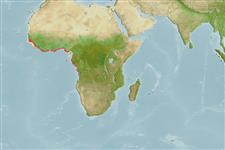Teleostei >
Clupeiformes (Herrings) >
Dorosomatidae (Gizzard shads and sardinellas)
Etymology: Ethmalosa: Greek, ethmos, -ou = sieve, also the ethmoides bone + Latin, alausa = a fish cited by Ausonius and Latin, halec = pickle, dealing with the Greek word hals = salt; it is also the old Saxon name for shad = "alli" ; 1591 (Ref. 45335).
Environment: milieu / climate zone / depth range / distribution range
生态学
海洋; 淡水; 半咸淡水; 降海洄游 (Ref. 51243); 深度上下限 0 - 50 m (Ref. 54436), usually 0 - 50 m (Ref. 54436). ; 25°N - 8°S, 17°W - 14°E (Ref. 54436)
Atlantic Ocean: Eastern central Atlantic Ocean, from Dakhla in Western Sahara southward to Lobito Bay in Angola (Ref. 188, 5286, 81269, 81631), occasionally entering freshwater (Ref. 3509). Reports from Cape Verde Islands are based on an erroneous type locality for Clupea fimbriata by Bowdich (1825), which was later rectified as probably Gambia (Ref. 188, 5286, 94080).
Length at first maturity / 大小 / 重量 / 年龄
Maturity: Lm 17.0 range ? - 18.5 cm
Max length : 46.0 cm TL 雄鱼/尚未辨别雌雄; (Ref. 1989); common length : 25.0 cm TL 雄鱼/尚未辨别雌雄; (Ref. 187); 最大体重: 1.0 kg (Ref. 1989)
背棘 (总数) : 0; 背的软条 (总数) : 16 - 19; 臀棘: 0; 臀鳍软条: 19 - 25; 脊椎骨: 40 - 44. Diagnosis: Body fairly deep, compressed, scutes present along belly; upper jaw with distinct notch, into which tip of lower jaw fits; lower gillrakers long, fine and numerous, about 3 times as long as gill filaments, upper gillrakers bent sharply upward, V-shaped; pelvic fin rays with 1 unbranched and 7 branched rays; caudal fin tips long and pointed (Ref. 188). A faint dark spot behind gill cover, sometimes followed by others; dorsal fin tip black; caudal fin deep chrome yellow; golden tints on body (Ref. 188, 81269). Ethmalosa fimbriata resembles Sardinella aurita, Sardinella rouxi and especially Sardinella maderensis, but these are more slender, have a rounded upper jaw which is not notched and the upper gillrakers are not bent upward like an elbow (Ref. 188).
Ethmalosa fimbriata is found in fairly shallow coastal waters, lagoons and estuaries, and sometimes also in lower courses of coastal rivers, even more than 300 km up rivers (Ref. 187, 188, 81269, 81631). It feeds principally on phytoplankton, chiefly diatoms, filtered by the very fine gillraker sieve (Ref. 187, 188, 3166). It breeds throughout the year in waters of salinities 3.5-38 ppt, but with peaks in at least some areas; spawns in the sea, in estuaries and in rivers (Ref. 188). The largest fisheries are in Senegal, Sierra Leone, Ivory Coast, Nigeria and Cameroon, mainly in the dry season (Ref. 188).
Breeds all year in waters of salinities 3.5 to 38 ppt, but with peaks in at least some areas, becoming progressively later to south. Spawns in the sea, in estuaries and in rivers.
Whitehead, P.J.P., 1985. FAO Species Catalogue. Vol. 7. Clupeoid fishes of the world (suborder Clupeoidei). An annotated and illustrated catalogue of the herrings, sardines, pilchards, sprats, shads, anchovies and wolf-herrings. FAO Fish. Synop. 125(7/1):1-303. Rome: FAO. (Ref. 188)
人类利用
渔业: 高经济性; 养殖: 实验的
工具
特别资料
下载 XML
网络资源
Estimates based on models
Preferred temperature (Ref.
123201): 20.2 - 27.9, mean 26.4 °C (based on 180 cells).
Phylogenetic diversity index (Ref.
82804): PD
50 = 1.0000 [Uniqueness, from 0.5 = low to 2.0 = high].
Bayesian length-weight: a=0.00933 (0.00806 - 0.01080), b=3.05 (3.01 - 3.09), in cm total length, based on LWR estimates for this species (Ref.
93245).
营养阶层 (Ref.
69278): 2.5 ±0.25 se; based on food items.
回复力 (Ref.
120179): 高度, 族群倍增时间少于 15个月 (K=0.25-0.36; tm=1; Fec=16,000).
Prior r = 0.23, 95% CL = 0.15 - 0.34, Based on 1 full stock assessment.
Fishing Vulnerability (Ref.
59153): Low vulnerability (21 of 100).
Climate Vulnerability (Ref.
125649): High vulnerability (60 of 100).
Nutrients (Ref.
124155): Calcium = 181 [96, 321] mg/100g; Iron = 1.91 [1.04, 3.19] mg/100g; Protein = 19 [17, 21] %; Omega3 = 0.374 [0.211, 0.670] g/100g; Selenium = 65.7 [32.1, 137.4] μg/100g; VitaminA = 8.42 [3.24, 21.22] μg/100g; Zinc = 1.75 [1.23, 2.59] mg/100g (wet weight); based on
nutrient studies.
